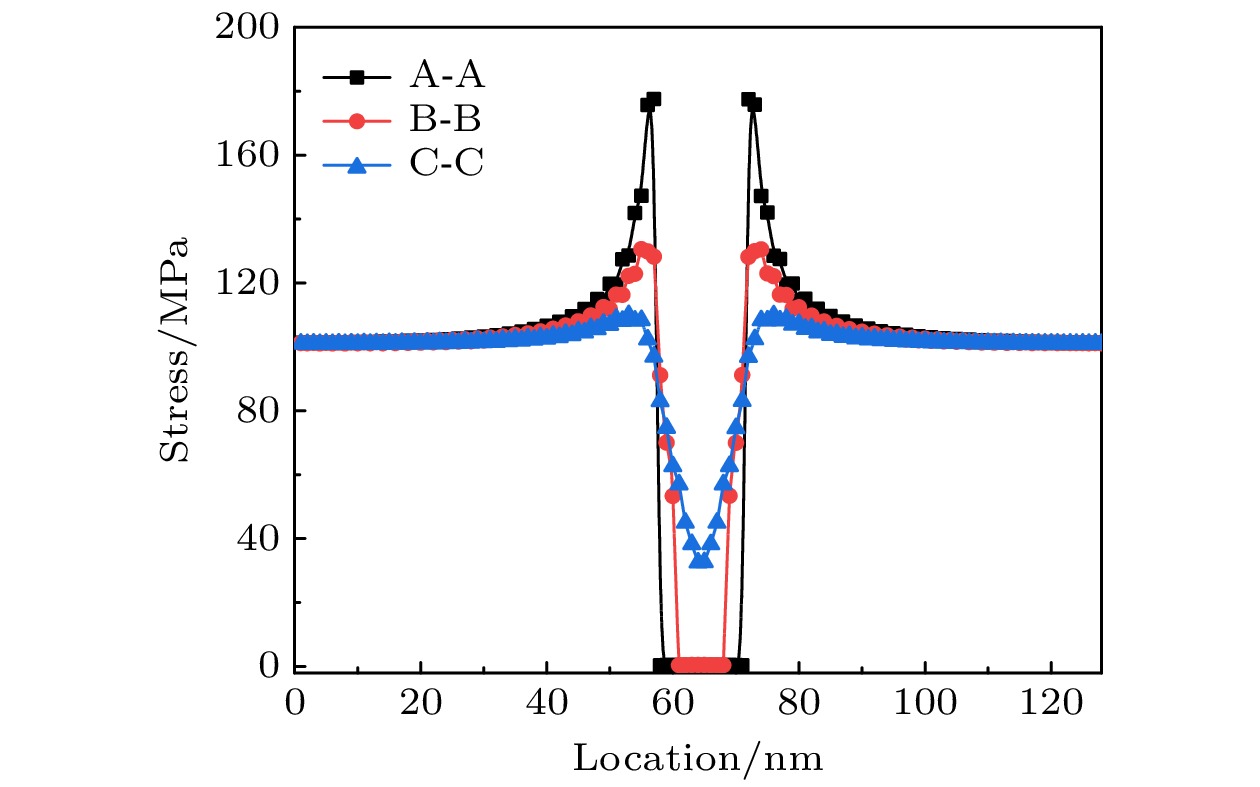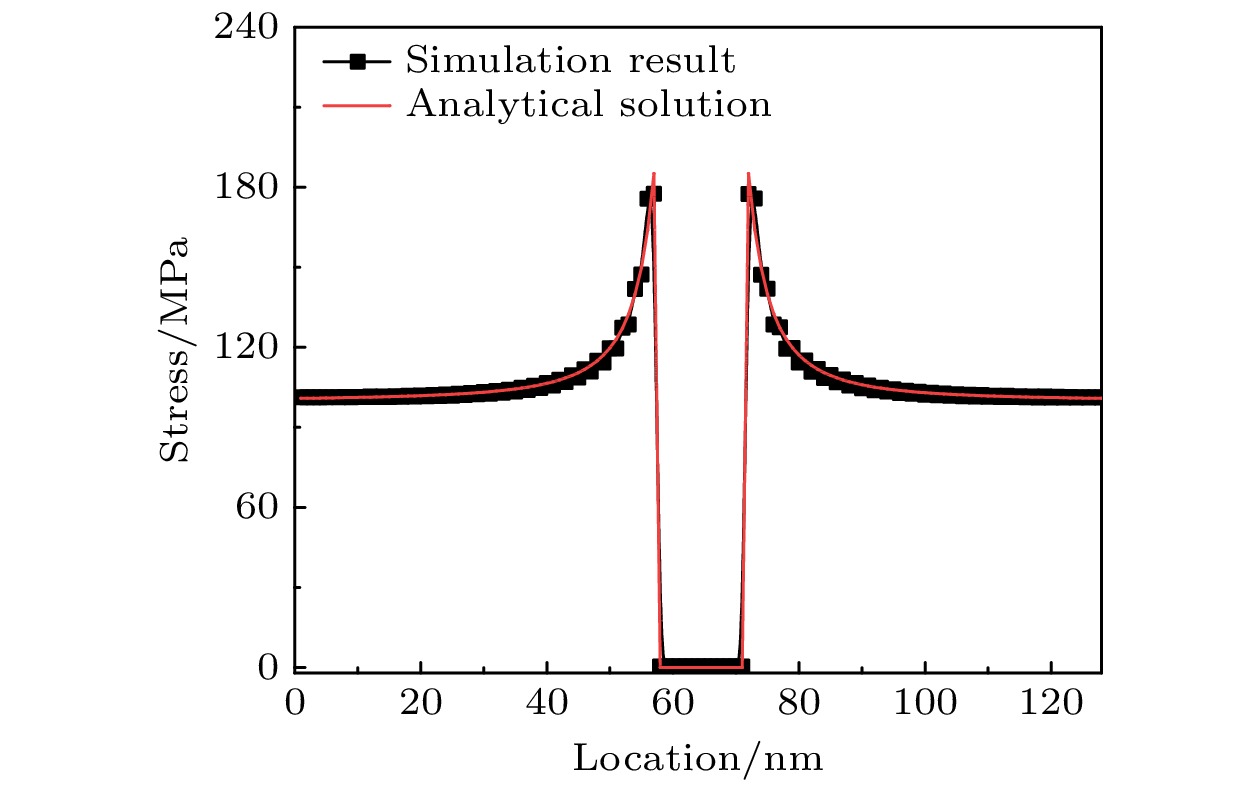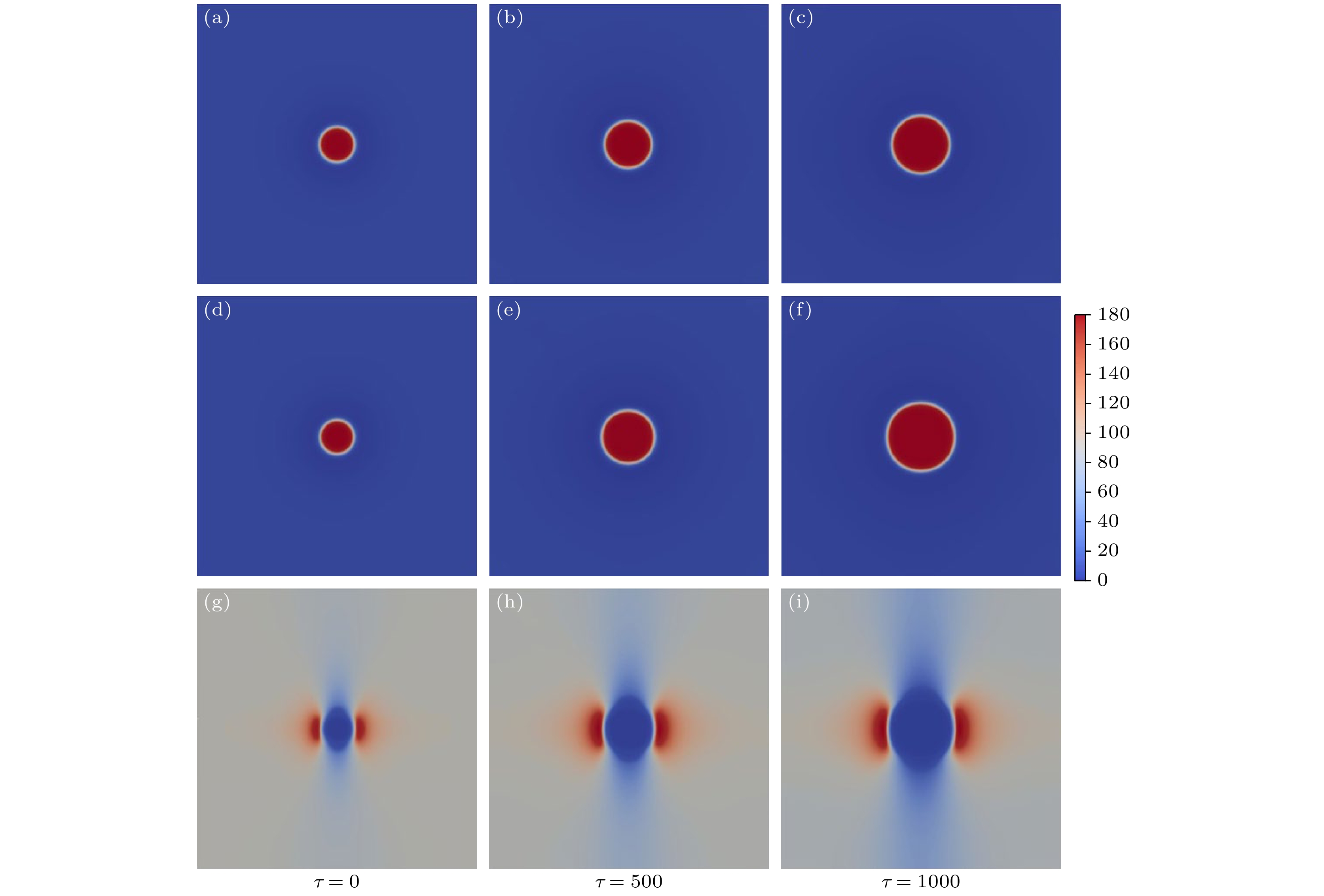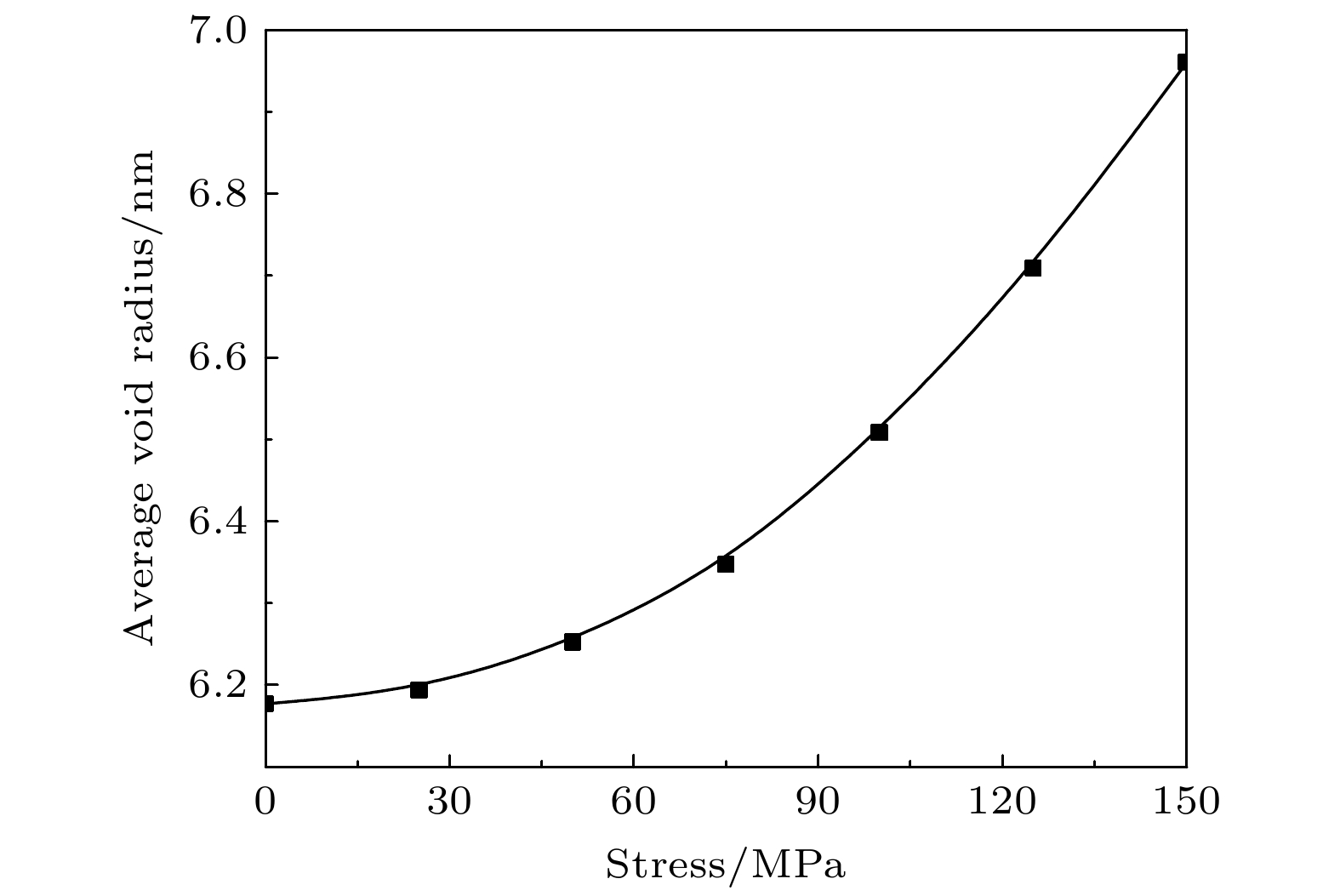-
本工作建立了外加应力作用下UO2中空洞演化的相场模型. 首先, 使用摄动迭代法求解了弹性平衡方程, 对外加应力下单个空洞周围的应力分布进行了计算, 结果表明空洞边缘有应力集中现象, 模拟得到的应力分布和解析解一致. 然后, 利用相场方法模拟了不同外加应力下单个空洞的演化过程, 结果表明随着外加应力的增大, 空洞的生长速度加快. 最后, 研究了外加应力对多晶体系中晶粒长大和空洞演化的影响, 结果表明, 不同晶粒内的应力大小不同, 应力越小的晶粒越容易长大, 尺寸越大的空洞的边缘应力也越大. 晶间空洞与弯曲晶界存在相互作用, 一方面晶界附近的空洞会生长成透镜状, 另一方面空洞对晶界也有钉扎作用, 能减缓晶界的迁移. 此外, 外加应力会加速多晶系统中空洞的生长, 并且本文计算得到了外加应力与空洞半径的关系, 发现外加应力越大, 空洞的生长越快.Owing to the migration and aggregation of point defects produced by cascade collision, a large number of cavities form easily during irradiation of the uranium dioxide (UO2) that is an important nuclear fuel. In addition, cavities are also inevitably introduced into the ceramic fuel during sintering. Moreover, the creep strain and thermal strain, caused by the extreme environment of high temperature and strong irradiation, significantly increase the applied stress of nuclear fuel. Therefore, it is crucial to investigate the microstructure evolution of the cavities in UO2 fuel under applied stress. In this work, a phase-field model of void evolution in UO2 under applied stress is established. Firstly, the elastic equilibrium equation is solved by the perturbation-iterative method, and the stress distribution around a single void under applied stress is calculated. The results show that the stress concentration is observed at the edge of the void, and the simulated stress distribution is consistent with the theoretically analytical results. Then, the evolution processes of a single void under different applied stresses are simulated by the phase-field model. The results show that the growth rate of void increases with the augment of applied stress. Finally, the effect of applied stress on grain growth and void evolution in polycrystalline are also studied. The results show that the applied stress will accelerate the void growth. With the increase of the applied stress, the effect of the applied stress on accelerating the void evolution increases.
-
Keywords:
- phase field model /
- void evolution /
- grain growth /
- applied stress
[1] Govers K, Lemehov S, Hou M, Verwerft M 2007 J. Nucl. Mater. 366 161
 Google Scholar
Google Scholar
[2] 杨辉, 冯泽华, 王贺然, 张云鹏, 陈铮, 信天缘, 宋小蓉, 吴璐, 张静 2021 70 054601
 Google Scholar
Google Scholar
Yang H, Feng Z H, Wang H R, Zhang Y P, Chen Z, Xin T Y, Song X R, Wu L, Zhang J 2021 Acta Phys. Sin. 70 054601
 Google Scholar
Google Scholar
[3] 孙正阳, 杨超, 柳文波 2020 金属学报 56 1295
Sun Z Y, Yang C, Liu W B 2020 Acta Metall. Sin. 56 1295
[4] Solomon A A 1973 J. Am. Ceram. Soc. 56 164
 Google Scholar
Google Scholar
[5] Brask D N 1979 J. Nucl. Mater. 83 265
 Google Scholar
Google Scholar
[6] Porter D L, Takata M L, Wood E L 1983 J. Nucl. Mater. 116 272
 Google Scholar
Google Scholar
[7] Sahu H K, Jung P 1985 J. Nucl. Mater. 136 154
 Google Scholar
Google Scholar
[8] Brager H R, Garner F A, Guthrie G L 1977 J. Nucl. Mater. 66 301
 Google Scholar
Google Scholar
[9] Jiang Y, Liu W, Li W, Sun Z, Xin Y, Chen P, Yun D 2021 Comput. Mater. Sci. 188 110176
 Google Scholar
Google Scholar
[10] Millett P C, Rokkam S, El-Azab A, Tonks M, Wolf D 2009 Model. Simul. Mater. Sci. Eng. 17 64003
 Google Scholar
Google Scholar
[11] Brailsford A D, Bullough R, Hayns M R 1976 J. Nucl. Mater. 60 246
 Google Scholar
Google Scholar
[12] Wiedersich H 1972 Radiat. Eff. Defect. S. 12 111
 Google Scholar
Google Scholar
[13] Millett P C, El-Azab A, Rokkam S, Tonks M, Wolf D 2011 Comput. Mater. Sci. 50 949
 Google Scholar
Google Scholar
[14] Millett P C, El-Azab A, Wolf D 2011 Comput. Mater. Sci. 50 960
 Google Scholar
Google Scholar
[15] Liu W B, Wang N, Ji Y Z, Song P C, Zhang C, Yang Z G, Chen L Q 2016 J. Nucl. Mater. 479 316
 Google Scholar
Google Scholar
[16] 杨朝曦, 柳文波, 张璁雨, 贺新福, 孙正阳, 贾丽霞, 师田田, 恽迪 2021 70 116101
 Google Scholar
Google Scholar
Yang Z X, Liu W B, Zhang C Y, He X F, Sun Z Y, Jia L X, Shi T T, Yun D 2021 Acta Phys. Sin. 70 116101
 Google Scholar
Google Scholar
[17] Hu S Y, Chen L Q 2001 Acta Mater. 49 1879
 Google Scholar
Google Scholar
[18] Wang J J, Bhattacharyya S, Li Q, Heo T W, Ma X Q, Chen L 2012 Phil. Mag. Lett. 92 327
[19] Kim D, Kim S G, Kim W T, Cho J, Han H N, Cha P 2011 Scr. Mater. 64 1079
 Google Scholar
Google Scholar
[20] Chang K, Lee G, Kwon J 2016 Radiat. Eff. Defect. S. 171 242
 Google Scholar
Google Scholar
[21] Salvo M, Sercombe J, Ménard J, Julien J, Helfer T, Désoyer T 2015 J. Nucl. Mater. 456 54
 Google Scholar
Google Scholar
[22] Cahn J W, Hilliard J E 1958 J. Chem. Phys. 28 258
 Google Scholar
Google Scholar
[23] Tonks M R, Zhang Y, Butterfield A, Bai X 2015 Model. Simul. Mater. Sci. Eng. 23 45009
 Google Scholar
Google Scholar
[24] Wang Y U, Jin Y M, Khachaturyan A G 2002 J. Appl. Phys. 92 1351
 Google Scholar
Google Scholar
[25] Sheng G, Bhattacharyya S, Zhang H, Chang K, Shang S L, Mathaudhu S N, Liu Z K, Chen L Q 2012 Mater. Sci. Eng. A 554 67
 Google Scholar
Google Scholar
[26] Tonks M, Millett P 2011 Mater. Sci. Eng. A 528 4086
 Google Scholar
Google Scholar
[27] Yan L L, Liu C Z, Ying Y Z, Zheng C 2014 Chinese Phys. B 23 69102
 Google Scholar
Google Scholar
[28] Wang Y U, Jin Y M, Khachaturyan A G 2002 J. Appl. Phys. 91 6435
 Google Scholar
Google Scholar
[29] Moelans N, Blanpain B, Wollants P 2008 Calphad 32 268
 Google Scholar
Google Scholar
[30] Chen L Q, Shen J 1998 Comput. Phys. Commun. 108 147
 Google Scholar
Google Scholar
[31] Kang K H, Ryu H J, Song K C, Yang M S 2002 J. Nucl. Mater. 301 242
 Google Scholar
Google Scholar
[32] Aagesen L K, Schwen D, Tonks M R, Zhang Y 2019 Comput. Mater. Sci. 161 35
 Google Scholar
Google Scholar
[33] Kinoshita M 1997 J. Nucl. Mater. 248 185
 Google Scholar
Google Scholar
[34] Freyss M, Petit T, Crocombette J 2005 J. Nucl. Mater. 347 44
 Google Scholar
Google Scholar
[35] Xiao H, Long C, Chen H, Tian X, Wei T, Zhao Y, Gao W 2015 Appl. Surf. Sci. 351 517
 Google Scholar
Google Scholar
[36] Chen T, Chen D, Sencer B H, Shao L 2014 J. Nucl. Mater. 452 364
 Google Scholar
Google Scholar
[37] Fritz I J 1976 J. Appl. Phys. 47 4353
 Google Scholar
Google Scholar
[38] Jin Y M, Wang Y U, Khachaturyan A G 2003 Philos. Mag. 83 1587
 Google Scholar
Google Scholar
[39] 徐芝纶 1982 弹性力学(上卷) (北京: 高等教育出版社) 第89页
Xu Z L 1982 Elasticity (Vol. 1) (Beijing: Higher Education Press) p89 (in Chinese)
[40] Wang H, Biswas S, Han Y, Tomar V 2018 Comput. Mater. Sci. 150 169
 Google Scholar
Google Scholar
[41] Heo T W, Bhattacharyya S, Chen L 2013 Philos. Mag. 93 1468
 Google Scholar
Google Scholar
[42] Aagesen L K, Gao Y, Schwen D, Ahmed K 2018 Phys. Rev. E 98 23309
 Google Scholar
Google Scholar
[43] 孙正阳, 王昱天, 柳文波 2020 金属学报 56 1643
 Google Scholar
Google Scholar
Sun Z Y, Wang L T, Liu W B 2020 Acta Metall. Sin. 56 1643
 Google Scholar
Google Scholar
[44] Liu W B, Ji Y Z, Tan P K, Zang H, He C H, Yun D, Zhang C, Yang Z G 2016 Materials 9 105
 Google Scholar
Google Scholar
-
表 1 模拟中使用的UO2参数
Table 1. Parameters of UO2 used in the simulation
参量 符号 取值 参考文献 绝对温度 T 1173 K 玻尔兹曼常数 kB 1.381 × 10–23 J/K 晶格常数 a 0.552 nm [31] 迁移率 L 1.56 × 10–11 m3/(J·s) [32] 梯度自由能参数 κ 3.38 × 10–8 J/m [32] 空位扩散系数 $ {D_{\text{v}}} $ 5.586 × 10–18 m2/s [33] 空位形成能 $ E_{\text{v}}^{\text{f}} $ 5.10 eV [34] 表面能 ${\gamma _{\text{s}}}$ 1.76 eV [35] 晶界能 ${\gamma _{{\text{GB}}}}$ 1.67 eV [36] 弹性模量 C11 389.3 GPa [37] C12 118.7 GPa [37] C44 59.7 GPa [37] -
[1] Govers K, Lemehov S, Hou M, Verwerft M 2007 J. Nucl. Mater. 366 161
 Google Scholar
Google Scholar
[2] 杨辉, 冯泽华, 王贺然, 张云鹏, 陈铮, 信天缘, 宋小蓉, 吴璐, 张静 2021 70 054601
 Google Scholar
Google Scholar
Yang H, Feng Z H, Wang H R, Zhang Y P, Chen Z, Xin T Y, Song X R, Wu L, Zhang J 2021 Acta Phys. Sin. 70 054601
 Google Scholar
Google Scholar
[3] 孙正阳, 杨超, 柳文波 2020 金属学报 56 1295
Sun Z Y, Yang C, Liu W B 2020 Acta Metall. Sin. 56 1295
[4] Solomon A A 1973 J. Am. Ceram. Soc. 56 164
 Google Scholar
Google Scholar
[5] Brask D N 1979 J. Nucl. Mater. 83 265
 Google Scholar
Google Scholar
[6] Porter D L, Takata M L, Wood E L 1983 J. Nucl. Mater. 116 272
 Google Scholar
Google Scholar
[7] Sahu H K, Jung P 1985 J. Nucl. Mater. 136 154
 Google Scholar
Google Scholar
[8] Brager H R, Garner F A, Guthrie G L 1977 J. Nucl. Mater. 66 301
 Google Scholar
Google Scholar
[9] Jiang Y, Liu W, Li W, Sun Z, Xin Y, Chen P, Yun D 2021 Comput. Mater. Sci. 188 110176
 Google Scholar
Google Scholar
[10] Millett P C, Rokkam S, El-Azab A, Tonks M, Wolf D 2009 Model. Simul. Mater. Sci. Eng. 17 64003
 Google Scholar
Google Scholar
[11] Brailsford A D, Bullough R, Hayns M R 1976 J. Nucl. Mater. 60 246
 Google Scholar
Google Scholar
[12] Wiedersich H 1972 Radiat. Eff. Defect. S. 12 111
 Google Scholar
Google Scholar
[13] Millett P C, El-Azab A, Rokkam S, Tonks M, Wolf D 2011 Comput. Mater. Sci. 50 949
 Google Scholar
Google Scholar
[14] Millett P C, El-Azab A, Wolf D 2011 Comput. Mater. Sci. 50 960
 Google Scholar
Google Scholar
[15] Liu W B, Wang N, Ji Y Z, Song P C, Zhang C, Yang Z G, Chen L Q 2016 J. Nucl. Mater. 479 316
 Google Scholar
Google Scholar
[16] 杨朝曦, 柳文波, 张璁雨, 贺新福, 孙正阳, 贾丽霞, 师田田, 恽迪 2021 70 116101
 Google Scholar
Google Scholar
Yang Z X, Liu W B, Zhang C Y, He X F, Sun Z Y, Jia L X, Shi T T, Yun D 2021 Acta Phys. Sin. 70 116101
 Google Scholar
Google Scholar
[17] Hu S Y, Chen L Q 2001 Acta Mater. 49 1879
 Google Scholar
Google Scholar
[18] Wang J J, Bhattacharyya S, Li Q, Heo T W, Ma X Q, Chen L 2012 Phil. Mag. Lett. 92 327
[19] Kim D, Kim S G, Kim W T, Cho J, Han H N, Cha P 2011 Scr. Mater. 64 1079
 Google Scholar
Google Scholar
[20] Chang K, Lee G, Kwon J 2016 Radiat. Eff. Defect. S. 171 242
 Google Scholar
Google Scholar
[21] Salvo M, Sercombe J, Ménard J, Julien J, Helfer T, Désoyer T 2015 J. Nucl. Mater. 456 54
 Google Scholar
Google Scholar
[22] Cahn J W, Hilliard J E 1958 J. Chem. Phys. 28 258
 Google Scholar
Google Scholar
[23] Tonks M R, Zhang Y, Butterfield A, Bai X 2015 Model. Simul. Mater. Sci. Eng. 23 45009
 Google Scholar
Google Scholar
[24] Wang Y U, Jin Y M, Khachaturyan A G 2002 J. Appl. Phys. 92 1351
 Google Scholar
Google Scholar
[25] Sheng G, Bhattacharyya S, Zhang H, Chang K, Shang S L, Mathaudhu S N, Liu Z K, Chen L Q 2012 Mater. Sci. Eng. A 554 67
 Google Scholar
Google Scholar
[26] Tonks M, Millett P 2011 Mater. Sci. Eng. A 528 4086
 Google Scholar
Google Scholar
[27] Yan L L, Liu C Z, Ying Y Z, Zheng C 2014 Chinese Phys. B 23 69102
 Google Scholar
Google Scholar
[28] Wang Y U, Jin Y M, Khachaturyan A G 2002 J. Appl. Phys. 91 6435
 Google Scholar
Google Scholar
[29] Moelans N, Blanpain B, Wollants P 2008 Calphad 32 268
 Google Scholar
Google Scholar
[30] Chen L Q, Shen J 1998 Comput. Phys. Commun. 108 147
 Google Scholar
Google Scholar
[31] Kang K H, Ryu H J, Song K C, Yang M S 2002 J. Nucl. Mater. 301 242
 Google Scholar
Google Scholar
[32] Aagesen L K, Schwen D, Tonks M R, Zhang Y 2019 Comput. Mater. Sci. 161 35
 Google Scholar
Google Scholar
[33] Kinoshita M 1997 J. Nucl. Mater. 248 185
 Google Scholar
Google Scholar
[34] Freyss M, Petit T, Crocombette J 2005 J. Nucl. Mater. 347 44
 Google Scholar
Google Scholar
[35] Xiao H, Long C, Chen H, Tian X, Wei T, Zhao Y, Gao W 2015 Appl. Surf. Sci. 351 517
 Google Scholar
Google Scholar
[36] Chen T, Chen D, Sencer B H, Shao L 2014 J. Nucl. Mater. 452 364
 Google Scholar
Google Scholar
[37] Fritz I J 1976 J. Appl. Phys. 47 4353
 Google Scholar
Google Scholar
[38] Jin Y M, Wang Y U, Khachaturyan A G 2003 Philos. Mag. 83 1587
 Google Scholar
Google Scholar
[39] 徐芝纶 1982 弹性力学(上卷) (北京: 高等教育出版社) 第89页
Xu Z L 1982 Elasticity (Vol. 1) (Beijing: Higher Education Press) p89 (in Chinese)
[40] Wang H, Biswas S, Han Y, Tomar V 2018 Comput. Mater. Sci. 150 169
 Google Scholar
Google Scholar
[41] Heo T W, Bhattacharyya S, Chen L 2013 Philos. Mag. 93 1468
 Google Scholar
Google Scholar
[42] Aagesen L K, Gao Y, Schwen D, Ahmed K 2018 Phys. Rev. E 98 23309
 Google Scholar
Google Scholar
[43] 孙正阳, 王昱天, 柳文波 2020 金属学报 56 1643
 Google Scholar
Google Scholar
Sun Z Y, Wang L T, Liu W B 2020 Acta Metall. Sin. 56 1643
 Google Scholar
Google Scholar
[44] Liu W B, Ji Y Z, Tan P K, Zang H, He C H, Yun D, Zhang C, Yang Z G 2016 Materials 9 105
 Google Scholar
Google Scholar
计量
- 文章访问数: 8077
- PDF下载量: 125
- 被引次数: 0














 下载:
下载:













